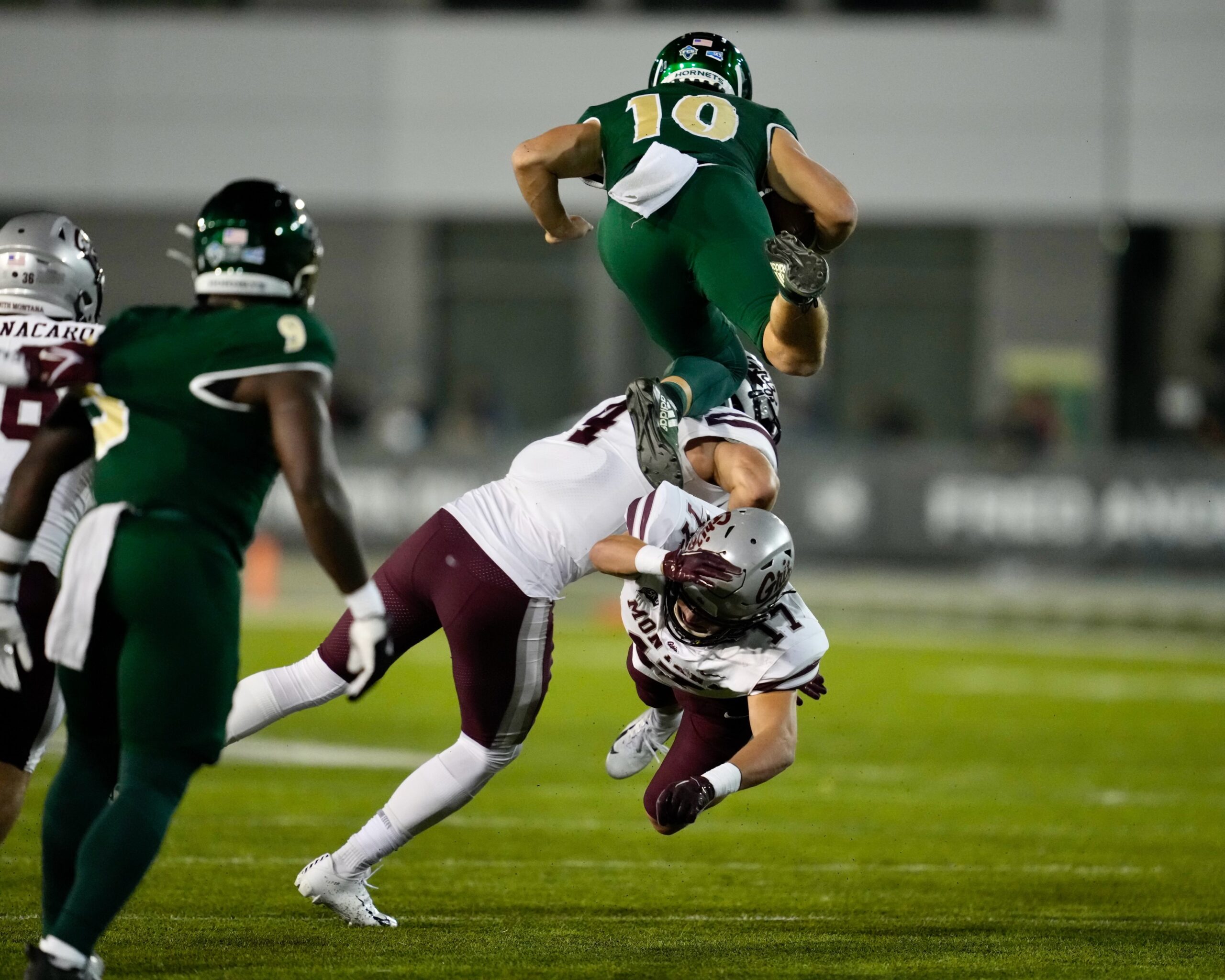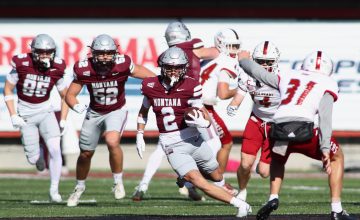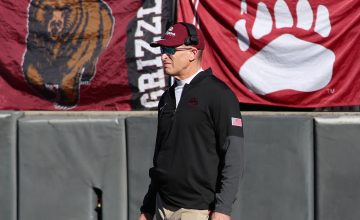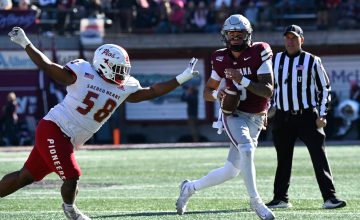Every week, we’ll cover every game from around the Big Sky, going beyond the box score with analysis and thoughts on every team. This week on the Big Sky Scramble: it is time, once again, for power rankings, focusing on the teams still contending for the FCS playoffs.
SACRAMENTO STATE
I have concerns, still, about the Hornets’ defense (although they’re up to third in the conference in scoring defense and fifth in total defense). I have no confidence that they will be able to get a stop when it matters. I wasn’t that impressed by their last two games, when they had to come from behind against a Montana team that played almost the entire game with backup quarterback Kris Brown and an Idaho team that…actually, no caveats with that one, great win.
On the other hand, those games should have answered any lingering questions about Sac State’s ability to play without the lead after they didn’t trail once for the first six games of the season. More importantly, the Hornets might just be unstoppable, especially when they line up running quarterback Asher O’Hara (scored the tying and winning touchdowns against Montana, and the winning touchdown against Idaho) next to running back Cameron Skattebo (still averaging 7.8 yards per carry, and his 123 rushing yards per game would be the most for a Big Sky back in a full season since Joe Protheroe was running the triple option at Cal Poly). The biggest reason they were held to 31 points in each of those games was uncharacteristic decision-making by Jake Dunniway, who threw three picks against the Griz and two against Idaho. I can still see the slightest glimmer of a way Sac State could get upset in the playoffs again. But right now the Hornets’ record and stats speak for themselves.
O'Hara threads the needle for Pierre Williams for the 8-yard strike… The Hornets' lead balloons to 24-7 in the 3rd quarter… #StingersUp @BigSkyFB pic.twitter.com/62tquOBgjo
— Sac State Football (@SacHornetsFB) October 30, 2022
WEBER STATE
Weber State over Montana State after the Bobcats got the head-to-head win just two weeks ago? Leaving aside the weirdness of that game (and there will be more on it in the very next section), the Wildcats were very impressive in Bozeman.
Quarterback Bronson Barron was effective, efficient and very good in the important moments at the end of the game. Josh Davis’ injury isn’t a good thing, but they’ve discovered an effective 1-2 punch behind him with Damon Bankston and Dontae McMillan, and having Davis, who went over 600 career carries earlier this year, back fresh for the playoffs isn’t the worst thing in the world.

The Wildcats’ defense is also perfectly built to go against modern offenses. They’re giving up 4.7 yards per pass attempt, which is second in the nation behind Jackson State (you might have heard of them) and nearly a full yard better than anybody else in the country (Montana, at 6.1, is next-best in the Big Sky). They’ve given up six passing touchdowns and have 13 interceptions, and take away that side of the ball more effectively than anybody in the country. Montana State, which doesn’t care about throwing the ball, just happened to be one of the very few teams in the nation not affected by that. Sac State, who they play this week, ironically might be another. So are North Dakota State and South Dakota State. But that’s the whole list.
MONTANA STATE
I’m just going to publish the bit I wrote about last week’s Montana State game, instead of something new, because 1) the ‘Cats had a bye, 2) I already had it written, and 3) I think it illustrates something important about Montana State anyway.
The view from the press box (and the field, for the second half of the game) was that last Saturday’s unbelievable Weber State-Montana State matchup was decided, more than anything, by pragmatism – by willingness or unwillingness to acknowledge and adapt to the unique circumstances on a rainy, 40-degree day in Bozeman. Plenty has already been written about the four bad punt snaps that gave the Bobcats eight free points in a 43-38 win. But it was borderline coaching malpractice for Jay Hill – who has proven himself to be one of the best coaches in the league – to send Grant Sands back out on the field for the third and especially the fourth snap after he’d already whistled two through the end zone. It can be tough to come up with an entirely new plan in the middle of a heated, competitive game, and the first three bad snaps happened so quickly, back-to-back-to-back.
But by the time the last one happened, early in the third quarter, Hill not only had mountains of evidence that there was something wrong with his long snapper, but an entire halftime break to brainstorm solutions to the problem. It doesn’t matter what else they thought they had to fix – the entire Weber State coaching staff should have been in the visitors’ locker room at halftime trying to scheme up a way to successfully execute a punt.

Plan B could have been simple, like having somebody else long snap (and, indeed, backup tight end Logan Snyder, who was snapping on the field at halftime, was the triggerman on the Wildcats’ lone successful punt of the game). It could have been unorthodox, like going for it every time or doing a normal shotgun snap to quarterback Bronson Barron and having him quick kick. It could have been completely off the wall, like doing a normal shotgun snap back to Barron and having him pitch the ball from there back to punter Jack Burgess (This one is particularly fun because Burgess is an Aussie, from the excellently-named town of Bacchus Marsh in Victoria state, who should be able to at least get a kick away with both feet, so you can have Barron pitch it to him going either right or left).
Those are all crazy options! They also all would have been better than sending Sands out there again. It’s impossible to plan for your long snapper breaking. It’s not a situation you work on in practice or consider in meetings. None of that matters when it’s actually happening! You just have to find a way to get past it! You can’t keep proceeding with the normal order of operations, hoping or assuming that it’ll work out this time!
If you took one thing from that rant, I hope it was this: See and approach the game as it is, not as you wish it could be. Montana State’s Brent Vigen realized that early on Saturday, and it was easy to see because of how the Bobcats’ offense changed throughout the game. I thought it was obvious very early on that executing a normal drop-back passing offense was going to be impossible, that something as simple as throwing a slant route was a losing proposition because asking the quarterback to make an accurate throw and the receiver to make a tough catch on a hard-thrown ball was just too many things that had to go right on a day as sodden as that.
After seeing that, Vigen and the Bobcats tried to throw the ball as little as possible and, when they did, tried to make things as easy for Mellott and the receivers as possible.
Despite still being down multiple scores at the start of that stretch, Mellott attempted just nine more passes in the two-and-a-half quarters after the drive that included the Treyton Pickering drop shown above. He completed seven for 84 yards and his only touchdown.
Weber State, meanwhile, continued to try to execute their regular passing concepts.
Vigen’s pragmatism has been a huge strength for MSU during his year and a half in charge. Think back to last year, when he wasn’t handcuffed by the status quo of keeping his starting quarterback on the field. Instead, he saw the situation for what it was, put Tommy Mellott in and ripped off a run to the national title game. This year, the Bobcats once again have plenty of talent. But one of the biggest reasons why they’re still a national title contender despite losing four NFL-caliber players is because Vigen and his staff have shown themselves to be adept at quickly diagnosing and adapting to changing conditions, whether that’s over the arc of a season or in the heat of a game.
IDAHO
Who’s been the best big-game player in the Big Sky so far this year? I would say that it’s been Vandals receiver Hayden Hatten, who followed up his 9/149/2 line against Montana earlier in the month with seven catches for 113 yards and three scores against Sacramento State. All three touchdowns against the Hornets came in a 12-minute stretch across the third and fourth quarters to give Idaho a short-lived lead. All three touchdowns were hilariously identical – Idaho went heavy backfield, lined Hatten up as the only player split wide, got him one-on-one with no help, and let him win his matchup.
TOUCHDOWN VANDALS!
— Idaho Football (@VandalFootball) October 30, 2022
Hayden Hatten with his second TD of the game. Vandals have cut the lead to 24-21 with 8:26 to play!#GoVandals pic.twitter.com/9fGDQj1og0
He’s a hell of a cover one-on-one, as Montana found out a few weeks ago in Washington-Grizzly Stadium, mostly because of his physicality and ball skills – there doesn’t need to be a lot of separation for him to make the catch. In Idaho’s last four games, he’s got 27 catches, 440 yards and eight touchdowns.
It is Hayden Hatten's world, we are all just living in it!
— Idaho Football (@VandalFootball) October 30, 2022
Vandals take the 28-24 lead with 6:26 to play in the game!#GoVandals pic.twitter.com/JDcolrslLA
MONTANA
Watching Hatten dominate for a full month has brought into sharp contrast an issue that’s been kicking around the Griz for a little while. Mitch Roberts is a solid veteran. Cole Grossman, Aaron Fontes, Malik Flowers and Keelan White all look the part and they’ve all had hype at various points in their Montana careers. Right now, though, none of them can get open and get separation consistently. The Griz have one 100-yard receiving game this year – Roberts with 103 against Northwestern State.

I get it. The offensive playcalling has been inconsistent and maddening. Kris Brown has been hesitant and ineffective the last two weeks. Plenty of blame for the offense’s struggles lie at the feet of those two issues. It’s easy to look at Fontes or Grossman and believe that they’re stars-in-waiting, would-be gamechangers who are being failed by factors outside their control. But if any of those guys were THAT GUY, it would show up regardless. Do the Griz have a single receiver who is among the top 15 in the league at the position?
(Of course, a couple of those guys will probably go off against Cal Poly this week, less because I made this point than because the Mustangs are giving up 9.1 yards per pass attempt.)
UC DAVIS
It was awfully tempting to rank the Aggies over Montana, given that they have the exact same resume right now – zero wins over quality teams, multiple close losses to top-five opponents. That scenario could lead to an awful headache for the selection committee if the Griz lose to Montana State in the final game of the season and Davis beats either Idaho or (even more agonizingly) Sacramento State in one of the final two games. Do you take a 7-4 Griz team with no ranked wins, a 6-5 Aggies team with one (likely) top-10 win, both, or neither?
Everything about UC Davis screams that they’re a playoff-caliber team – one-possession losses to No. 1 South Dakota State and No. 5 Weber State, plus the way they’ve handled their business when the schedule finally eased up. The Aggies have scored 56, 58 and 59 points in against Northern Arizona, Northern Colorado and Cal Poly, respectively, and might be able to keep the pattern going this week against Idaho State.
PORTLAND STATE
EASTERN WASHINGTON
NORTHERN ARIZONA
CAL POLY
NORTHERN COLORADO
IDAHO STATE














